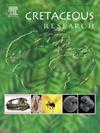美国密西西比湾塔斯卡卢萨群沉积体系变迁与层序地层演化:可容纳空间与沉积物供给控制
IF 1.7
3区 地球科学
Q1 GEOLOGY
引用次数: 0
摘要
塔斯卡卢萨群(Tuscaloosa Group, Grp)是墨西哥湾北部上白垩统地层的基础单元,形成于美国东南部的塞诺曼尼亚海侵晚期。尽管具有重要意义,但对密西西比湾中南部Tuscaloosa组的层序地层学综合分析仍然有限。本研究综合了岩心资料、电缆测井资料和野外观测资料,描述了其沉积演化和层序地层结构,圈定了地层表面、体系域和沉积层序,并研究了控制因素。从4个层序边界、2个海侵面和3个最大泛水面中识别出4个三级层序。层序1 (S1)包括低水位系统域(LST)、海侵系统域(TST)和高水位系统域(HST);序列2 (S2)具有TST和HST;序列3 (S3)包含LST、TST和HST;序列4 (S4)包括LST和TST。S1由河流和切谷沉积(LST)组成,在海平面上升期间过渡到三角洲TST,最终形成障壁岛和陆架HST。S2的特征是陆架远端TST沉积,之后是一个推进的三角洲HST。S3记录了一个完整的周期:河流LST -退积三角洲TST -进积三角洲HST。S4发育程度较低,主要为河流型地表温度沉积和局部退积型三角洲地表温度沉积。塔斯卡卢萨河的演变是由可容纳空间的变化和沉积物的供应驱动的。晚白垩世MSE的沉降可能增加了可容纳性,促进了上塔斯卡卢萨地区TST的形成。阿巴拉契亚高地提供了大部分沉积物,瓦希托高地是次要来源。本文章由计算机程序翻译,如有差异,请以英文原文为准。
Depositional system transitions and sequence stratigraphic evolution of the Tuscaloosa Group in the Mississippi Embayment, USA: Accommodation space and sediment supply controls
The Tuscaloosa Group (Grp), the basal unit of Upper Cretaceous strata in the northern Gulf of Mexico (GoM), formed during the late Cenomanian transgression across the southeastern United States. Despite its significance, comprehensive sequence stratigraphic analyses of the Tuscaloosa Grp within the south-central Mississippi Embayment (MSE) are limited. This study integrates core data, wireline logs, and field observations to characterize its depositional evolution and sequence stratigraphic architecture, delineating stratigraphic surfaces, systems tracts, and depositional sequences, and examining controlling factors. Four third-order sequences were identified from four sequence boundaries, two transgressive surfaces, and three maximum flooding surfaces. Sequence 1 (S1) includes a lowstand systems tract (LST), transgressive systems tract (TST), and highstand systems tract (HST); Sequence 2 (S2) has a TST and HST; Sequence 3 (S3) contains a LST, TST, and HST; and Sequence 4 (S4) includes a LST and TST. S1 comprises fluvial and incised valley deposits (LST), transitioned to deltaic TST during rising sea levels, and culminated in barrier island and shelf HST. S2 features distal shelf TST deposits followed by a prograding deltaic HST. S3 records a full cycle: fluvial LST, retrograding deltaic TST, and progradational deltaic HST. S4 is less developed, with fluvial LST and localized retrograding deltaic TST deposits. The Tuscaloosa's evolution was driven by accommodation space changes and sediment supply. Subsidence of the MSE in the Late Cretaceous may have increased accommodation and facilitated TST formation in the Upper Tuscaloosa. The Appalachian Highlands supplied most sediments, with the Ouachita Highlands as a secondary source.
求助全文
通过发布文献求助,成功后即可免费获取论文全文。
去求助
来源期刊

Cretaceous Research
地学-地质学
CiteScore
4.10
自引率
19.00%
发文量
235
审稿时长
12 weeks
期刊介绍:
Cretaceous Research provides a forum for the rapid publication of research on all aspects of the Cretaceous Period, including its boundaries with the Jurassic and Palaeogene. Authoritative papers reporting detailed investigations of Cretaceous stratigraphy and palaeontology, studies of regional geology, and reviews of recently published books are complemented by short communications of significant new findings.
Papers submitted to Cretaceous Research should place the research in a broad context, with emphasis placed towards our better understanding of the Cretaceous, that are therefore of interest to the diverse, international readership of the journal. Full length papers that focus solely on a local theme or area will not be accepted for publication; authors of short communications are encouraged to discuss how their findings are of relevance to the Cretaceous on a broad scale.
Research Areas include:
• Regional geology
• Stratigraphy and palaeontology
• Palaeobiology
• Palaeobiogeography
• Palaeoceanography
• Palaeoclimatology
• Evolutionary Palaeoecology
• Geochronology
• Global events.
 求助内容:
求助内容: 应助结果提醒方式:
应助结果提醒方式:


